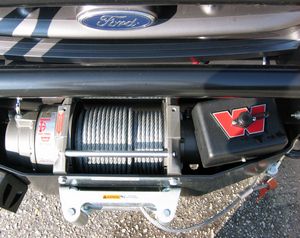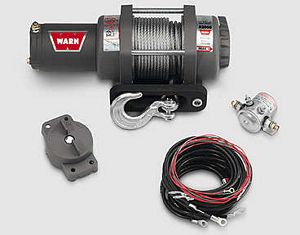|
By accessing or using The Crittenden Automotive Library™/CarsAndRacingStuff.com, you signify your agreement with the Terms of Use on our Legal Information page. Our Privacy Policy is also available there. |

8 Essential Winch Setup and Use Tips
|
|---|
|
|
8 Essential Winch Setup and Use Tips
Jason Lancaster
November 13, 2012
If you own a winch, learning how to use your winch safely while maximizing its' potential is absolutely critical. The last thing you want to be doing is figuring out how your winch works when you're stuck in the mud...in the middle of a rainstorm...in the dark.
Here's what you need to do before you go out on the trail.
1. Figure out your vehicle's battery capacity so you know how much you can winch before you run out of juice. There are two numbers you should be looking at when it comes to setting up and operating your winch. The first is the “Cold Cranking Amps” (CCA) figure. The second is the “Minute Reserve Capacity” (MRC) rating.
A higher CCA capacity not only ensures that your vehicle will start up immediately in cold temperatures, it also provides a greater amount of initial pull for most quality wenches. Meanwhile, the MRC capacity is important, as it determines how much pull the winch can sustain before the alternator fails to keep up with demand or the battery goes dead.
2. Is your alternator up to snuff? If you've got an older alternator, it's a great idea to get it tested. The alternator charges the battery, and charging the battery is important because your winch draws power from the battery. Right? If the alternator isn't working very well, consider replacing it with a higher capacity unit.
3. Check your wiring. The positive and ground battery cables should consist of Number 00 welding cable or similar material. The battery and the winch should be directly connected by the shortest length of cable possible. Avoid grounding the cable from the winch to the vehicle's frame or bumper, as this may introduce resistance between the winch motor and its electrical supply.
4. Remember to unspool before you pull. To achieve maximum pulling power, most winches rely on the ratio reduction of an unspooled drum. Therefore, you'll get the greatest pulling power (and the quickest recovery) by unspooling all but one layer of rope...so don't be afraid to park far away.
You can also use a tackle block to create a 50-percent increase in pulling power.
5. Pulling a continuous load for long periods is not recommended. Long, continuous pulls will a) drain your battery and b) strain your winch motor. To prevent unnecessary wear and tear, avoid pulling sustained loads for longer than one or two minutes at a time. Just pull for a minute, then stop and allow the motor to cool down for 2 minutes, then repeat. This will ensure you don't strain anything, and it will give you lots of time to make fun of the person who got stuck.
6. Break in your new rope before use. Doing so will prevent weak points from forming along the length of the rope, and will also help you ensure that the rope isn't defective.
To perform this task, pull all the rope off the spool save for six wraps. Hook the rope to a stationary object, and then pre-stretch the rope by drawing your vehicle along a hard, flat surface, applying only a moderate amount of brake resistance for this task. You're not trying to strain the motor, you're just trying to evenly stretch your rope.
7. Spool it up right. Improperly spooled winch rope isn't just ugly – it's the primary reason that winch ropes break at the wrong time. To respool the rope properly, unravel the rope and draw it back onto the spool, holding on tightly with moderate resistance. The rope should spool into tight, even rows.
8. Re-check battery status every few months. Lead-acid batteries can deteriorate pretty dramatically if they're depleted – even just one time. Therefore, before you go depending on your winch out in the middle of nowhere, it's smart to check your battery for charge.
Author
Jason Lancaster is the founder of WinchBin, a website dedicated to
all things related to winches.



















